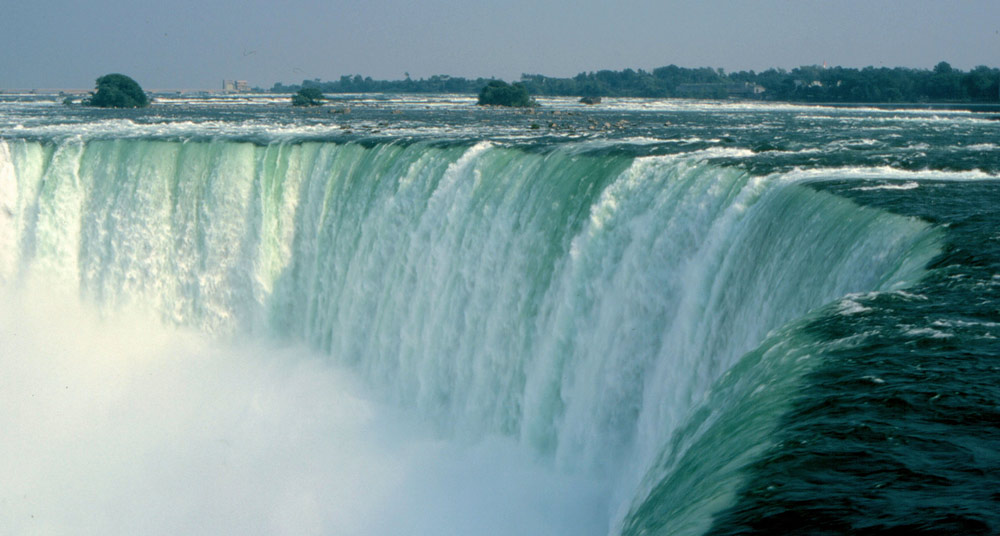Aerospace engineer Julian Sharpe is so confident in the disaster-proof pod he has invented that he is willing to test it by going over Niagara Falls.
“I’m aware there are huge restrictions, and it may not even be possible, in which case we would be looking for an alternative waterfall,” said Sharpe, 50, a British inventor who now lives in the United States. “There is one here in Washington that would be doable,”
Niagara Falls is the preferred site for Sharpe’s pod, which is built for people to survive natural disasters.
“Niagara is the pinnacle for this kind of thing and we would go to the authorities when we are ready,” he said.
A representative for the Niagara Parks Commission, the provincial agency responsible for the area around the falls, could not be reached Friday to comment on Sharpe’s proposal.
But the parks commission typically does not allow stunts on the Niagara River. Daredevils who have gone over the falls in barrels or other contraptions have done it without the government agency’s blessing. Survivors are usually charged.
The parks commission made an exception to its anti-stunting policy last year to allow wirewalker Nik Wallenda to cross the gorge on a tightrope. At the time, commissioner said it was a once-in-a-generation exception.
Sharpe said his pod would benefit people worldwide.
“We want to do something good for the world. There are 135 countries in the world that are exposed to the tsunami wave. The next big earthquake in Japan is expected to be south of Tokyo Bay where two-and-a-half million people are exposed.”
His capsules or pods are designed to hold two, four, six, eight or 10 people and would be tested under laboratory conditions before they would be sent over the Horseshoe Falls.
“We just want to make people aware that there is an option and that it’s pretty rugged … we know it’s going to be strong and we would send it over with crash-test dummies first of all just to understand the accelerations and g-loads, but then if hopefully we could get a permit, it would be nice to go over,” said Sharpe, a former Boeing engineer.
He has worked in the aerospace industry for six years and is the president and CEO of a company called Survival Capsule LLC.
Sharpe and vice-president Scott Hill would occupy two of the seats in the capsule going over the Falls, and the other four seats could be auctioned off with the money given to a local charity, he said.
He suggests advertising could also be sold on the outside of the capsule to help raise additional funds. His plan is not to profit from the Niagara Falls venture, but to show people how they can remain safe and to make them more aware of the lifesaving capabilities of the capsules.
Sharpe said Japan is quite interested in his invention because it could save many lives if they are struck by more tsunamis such as the ones that hit Thailand and Japan.
The capsules, which are made from aluminium, have been designed not only to withstand impacts and penetration from sharp objects, but also to guard against fire, which is a big problem during a tsunami.
“It cannot be built out of plastic because in a tsunami condition a lot of the debris fuel catches fire,” Sharpe said. “If you look at a lot of the images and videos that were taken you will see they had a lot of fires.”
The main danger in a tsunami is not drowning but from being crushed by the debris.
The pods could be stored on the roofs of buildings. In case of a disaster, people would head to the rooftop and get inside the pods.
Sharpe said many times people don’t have a means of escape. They have tried to use aerospace technology to give people a choice.
“We have come up with a device that can hopefully save lives in terms of riding the tsunami out rather than trying to flee from it.”
The company has built two full-sized and functioning prototypes. It has also teamed up with Eddie Bernard, who is a world-renowned expert and consultant on issues dealing with tsunami warning systems, tsunami mitigation and education programs, and tsunami research.
The company has made a video that shows a capsule being built and tested under stress conditions. The video was made so that it could be shown at the Japanese Disaster Preparedness Expo held earlier this month in Yokohama, Japan.
People who have used a ball-type capsule to go over Niagara Falls:
- 1928 — On July 4, Jean Lussier went over the falls in a large ball with a spring steel frame and a rubber covering
- 1951 — On Aug. 5, William “Red” Hill, Jr. (son of William “Red” Hill, Sr.) went over the falls in a craft he named “The Thing”. The vessel broke apart on impact and Hill was killed
- 1961 — On July 15, Nathan Boya (also known as William Fitzgerald) went over the falls in a rubber ball nicknamed the “Plunge-O-Sphere”
- 1993 — On Sept. 26, David Munday went over the falls in a steel ball. It was his second time over Niagara Falls. The first trip was in 1985. He tried again in 1990, but his barrel became stuck at the brink.






